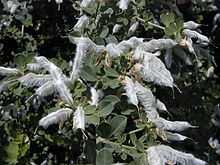Genista monspessulana
| Genista monspessulana | |
|---|---|
 | |
| Scientific classification | |
| Kingdom: | Plantae |
| (unranked): | Angiosperms |
| (unranked): | Eudicots |
| (unranked): | Rosids |
| Order: | Fabales |
| Family: | Fabaceae |
| Genus: | Genista |
| Species: | G. monspessulana |
| Binomial name | |
| Genista monspessulana (L.) O.Bolós & Vigo | |
Genista monspessulana (syn. Cytisus monspessulanus or Teline monspessulana) also known as French broom, Cape broom and Montpellier broom, is a woody perennial shrub and a legume. The species is native to the Mediterranean region, and is considered an invasive plant in most places where it has been introduced.[1]
Description
French broom, Genista monspessulana, grows to 1–2.5 metres (3 ft 3 in–8 ft 2 in) tall, with slender green branches. The leaves are evergreen, trifoliate with three narrow obovate leaflets, 1–2 centimetres (0.39–0.79 in) long. The flowers are yellow, grouped 3-9 together in short racemes. Like other legumes, it develops its seeds within a pod. The pods are 2–3 cm long, tough and hard, and are transported easily by flowing water and animals. They burst open with force, dispersing the seeds several metres. The plant begins seed production once it reaches a height of approximately 40 centimetres (16 in), and each plant can live for 10–20 years. One mature plant can produce 10,000 seeds per season. The generous seed production and the plant's ability to re-sprout after cutting or burning help it to invade new habitat vigorously when introduced.[2][3] [4]
It is related to the common broom and Spanish broom. This suite of plants is common in European shrublands. French broom was originally distributed throughout Mediterranean Europe and northwest Africa, the Azores, and the Canary Islands.[4] Due to its lower tolerance for frost than other broom species, it is common in warmer, lower elevation areas. It is found on coastal strips and in sunny inland areas, and does best with plentiful rainfall and sandy soils.

Invasiveness
When introduced to a new area, French broom can become an invasive plant. Its reproductive vigour and preference for Mediterranean climates make it a very successful species in California and the Pacific Northwest, where it is considered a severe noxious weed, covering over 40,000 hectares.[5] It is even more widespread in Australia, where it covers 600,000 hectares and is also considered a noxious weed.[6]
The plant often outcompetes native vegetation, forming dense fields where other species are almost completely crowded out. Stands of French broom can be so thick that they make meadows and pastures useless for wild and domestic animals. Other harmful effects include its ability to shade out tree seedlings in reforested areas, its tendency to catch fire, and the toxicity of its leaves and seeds, which contain alkaloids poisonous to many large domestic animals.[4]
See also
- Broom
References
- ↑ Integrated Taxonomic Information System. Genista monspessulana, webpage for taxonomic serial number 502738 retrieved May 19, 2007.
- ↑ Bossard, Carla (2000). Carla C. Bossard, John M. Randall, and Marc C. Hoshovsky, ed. "Genista Monspessulana," in Invasive Plants of California's Wildlands. Berkeley: University of California. ISBN 978-0-520-22546-6.
- ↑ D'Antonio, Carla (2007). ""Genista monspessulana". Agriculture and Natural Resources (University of California). Retrieved May 19, 2007.
- ↑ 4.0 4.1 4.2 Hoshovsky, Marc (1986). Element Stewardship Abstract for Cytisus scoparius and Genista monspessulanus (PDF). Arlington: The Nature Conservancy. Retrieved May 19, 2007.
- ↑ "Genista monspessulana". California Invasive Plant Council. Retrieved May 17, 2007.
- ↑ "Noxious Weed List for Australian States and Territories" (PDF). Cooperative Research Center for Australian Weed Management. Australian Weeds Committee. 2007. Retrieved May 19, 2007.
| Wikimedia Commons has media related to Genista monspessulana. |
External links
- USDA Genista monspessulana - French Broom Information Page
- French Broom Webpage from the Calflora.org website; the webpage gives links to additional photos. Retrieved May 17, 2007.
- Genista monspessulans (French Broom), from The Global Invasive Species Initiative website; the webpage has links to several photographs. Retrieved May 19, 2007.